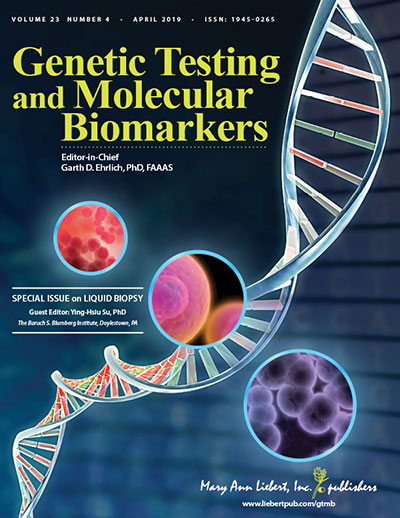For Immediate Release
Promise of Liquid Biopsy in Cancer Biomarker Detection and Prenatal Screening
Contact: Kathryn Ryan
914-740-2250
kryan@liebertpub.com

New Rochelle, NY, April 22, 2019—The promise and challenges of liquid biopsy, an emerging, noninvasive method for targeted disease diagnosis and detection of cancer biomarkers to enable improved and personalized therapy, is the focus of a new special issue of Genetic Testing and Molecular Biomarkers, a peer-reviewed journal from Mary Ann Liebert, Inc., publishers. Click here to read the full-text articles free on the Genetic Testing and Molecular Biomarkers website until May 20, 2019.
Under the leadership of Guest Editor Ying-Hsiu Su, PhD, The Baruch S. Blumberg Institute, Doylestown, PA, this special issue on liquid biopsy includes an extensive range of original research articles that demonstrate the exciting potential of this novel technology. Liquid biopsy, in which disease biomarkers are detected in bodily fluids, offers a noninvasive alternative to tissue biopsy. It makes it easier to monitor cancer progression more frequently, allowing clinicians to modify therapeutic regimens as tumors evolve to adapt to their environment and develop resistance to existing treatments. However, much more research is needed to understand fully the value and appropriate use of liquid biopsy.
Featured in this special issue is the article entitled “Detection of BRAFV600E Mutation in Melanoma Patients by Digital PCR of Circulating DNA” by Tatiana Burjanivova, PhD, Commenius University in Bratislava, Jessenius Faculty of Medicine in Martin, Slovakia and coauthors from this institution and University Hospital in Martin. The researchers demonstrated that droplet digital PCR is a highly sensitive method for detection the BRAFV600E genetic mutation – present in about 50% of melanomas – which is a good therapeutic target. The digital PCR technique detects the mutation in circulating cell-free DNA shed by the melanoma tumor into the blood.
In another example of how liquid biopsy can detect a cancer biomarker, Hui Kang, PhD, and colleagues from The First Affiliated Hospital of China Medical University, Shenyang, contributed the article “Identification of an Exosomal Long Noncoding RNA SOX2-OT in Plasma as a Promising Biomarker for Lung Squamous Cell Carcinoma.” Here, the researchers concluded that the long noncoding RNA SOX2-OT, which is released into the blood in fatty packets called exosomes, is present in significantly higher levels in patients with lung squamous cell carcinoma. Furthermore, in these patients there was a significant correlation between SOX2-OT levels and tumor size, stage of disease, and metastasis of the cancer to nearby lymph nodes.
Another article evaluated the use of liquid biopsy in prenatal testing for the diagnosis of trisomy 21 (Down syndrome). In the article entitled “Application of Differentially Methylated Loci in Clinical Diagnosis of Trisomy 21 Syndrome,” was coauthored Li Xiao, PhD, Second Affiliated Hospital of Soochow University, Suzhou, China and colleagues from this institution and Southern Illinois University, School of Medicine, Springfield, IL. An evaluation of different sets of fetal-specific methylation markers and the use of quantitative polymerase chain reaction (qPCR) led to the identification of combined marker set that could be highly sensitive, specific, cost-effective, and noninvasive prenatal screening tool to detect trisomy 21.
“Liquid biopsies, in their myriad forms, are revolutionizing laboratory testing; they will be the principal means of monitoring the body’s health and homeostatic mechanisms within the next decade. They will provide information for making diagnoses, monitoring treatment efficacy, and predicting outcomes," says Genetic Testing and Molecular Biomarkers Editor-in-Chief Garth D. Ehrlich, PhD, FAAAS, Professor of Microbiology and Immunology, Executive Director, Center for Genomic Sciences and Center for Advanced Microbial Processing, Institute for Molecular Medicine and Infectious Disease, Drexel College of Medicine (Philadelphia, PA).
About the Journal
Genetic Testing and Molecular Biomarkers is an authoritative peer-reviewed journal published 12 times per year online with open access options and in print that reports on all aspects of genetic testing, including molecular and biochemical based tests and varied clinical situations; ethical, legal, social, and economic aspects of genetic testing; and issues concerning effective genetic counseling. Tables of content and a free sample issue may be viewed on the Genetic Testing and Molecular Biomarkers website.
About the Publisher
Mary Ann Liebert, Inc., publishers is a privately held, fully integrated media company known for establishing authoritative peer-reviewed journals in many promising areas of science and biomedical research, including Human Gene Therapy and OMICS: A Journal of Integrative Biology. Its biotechnology trade magazine, GEN (Genetic Engineering & Biotechnology News), was the first in its field and is today the industry’s most widely read publication worldwide. A complete list of the firm’s 80 journals, books, and newsmagazines is available on the Mary Ann Liebert, Inc., publishers website.